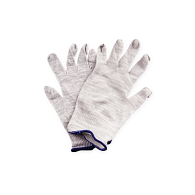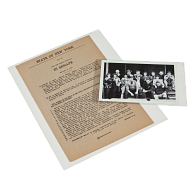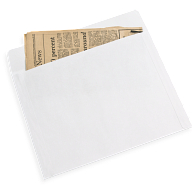Caring for Your Photography Collection
Photography has evolved through many processes since the early 19th century from that first daguerreotype to today's digital images. And the wide variety of images created using these different processes can be found in many collections. Some require more special handling than others. Each requires knowledge of the proper storage techniques. Following is a brief look at some of the most popular of these processes.
- Albumen Prints: These prints were created on paper using a coating of egg whites (albumen) as a binder. The most popular usage for this technique was to create Carte-de-Visites.
- Ambrotypes: Similar in appearance to a daguerreotype, ambrotypes are an underexposed collodion glass negative with a sheet of dark material placed behind it causing the negative to appear as a positive image. The image has a duller, less mirror-like surface than a daguerreotype.
- Cyanotypes: This process uses light sensitive iron salts instead of silver on paper. The prints are characterized by their blue color and are sometimes called blueprints. In photography, this process was used for making proofs.
- Daguerreotypes: An image is formed directly on a shiny silver-plated copper plate. It is a direct-positive process and has no negative. The finished image is reversed. The finished prints are often placed under glass and stored in decorative leather cases.
- Digital Prints: Images that are processed digitally and then printed. It is important to note that the sensitivities of digitally printed photographs to damage depends largely on the products used in the printing process and, as such, is highly variable.
- Gelatin Silver Prints: This is the most common process for making black and white photographs. The process used silver halide and a gelatin emulsion to create a print on paper from a negative. It has been used since the 1890s and is still in use today. Negatives have progressed from glass plate to flexible film, from cellulose nitrate to acetate to polyester.
- Gum Bichromate Prints: A non-silver printing method using paper coated with a solution of gum arabic, potassium or ammonium bichromate and a pigment to provide image tones. This process allows extensive physical manipulation by the photographer, resulting in unique, painterly images.
- Tintypes: Similar to an ambrotype and daguerreotype, the image is formed directly on a sheet of metal as a positive. The metal serves the same function as the dark material used in ambrotypes to cause the image to appear as positive. The image is reversed. The metal plates were often varnished, making their surface less vulnerable to abrasion. Tintypes were less expensive than other processes. They can often be found in paper mats or cases.
Develop a method of cataloguing and identifying prints and negatives for future reference. It is important to label items in a collection so that each image can be properly inventoried and identified over time. Care should be taken, however, to use safe implements for labeling. Always label photographs on the reverse. A soft, No. 2 pencil with a somewhat dull tip can be used for prints that have a paper surface backing. An All-Stabilio pencil or a blue photo marking pencil can be used for resin or plastic coated photographs. Do not press too hard when writing, as this will create an indentation on the front. For film and negatives, use a film marking pen. Do not write directly on the frames, but on the lead or a wide margin. A safer method is to mark the sleeve or the paper enclosure prior to inserting the film strip or negative. Do not use sticky notes or self-adhesive labels, as they will leave a residue that will discolor over time.
Handle all prints and negatives with anti-static gloves or cotton gloves to eliminate the possibility of damage from fingerprints or oils or of lint and dust clinging to the images.
Select the primary enclosure based on the usage. An image that will be handled often is better stored in a plastic enclosure for easy viewing. Use polyester, polypropylene, or polyethylene, which are all safe plastics for archival storage. Never store photos in vinyl.
An image that will not be referred to often should be stored in a paper enclosure for maximum protection against light. The most recent ISO standards advise storage of all types of photographs in buffered paper, although some archivists and curators prefer to use unbuffered materials for color prints, albumen prints, and cyanotypes. All paper enclosures should be acid-free and lignin-free.
Store photos in enclosures in sturdy, acid- and lignin-free boxes that match the size of the prints. When storing multiple sizes of prints together, put the largest photos on the bottom to avoid damaging smaller photos. To reduce cost and space usage, large photo collections can be stored without individual enclosures. Store those photos in boxes with interleaving paper, such as Permalife Bond Paper, between each photo.
The best storage environment for photographic materials is one that is cool, dark and dry. Following are the recommended temperature and humidity for different media:
- Film (color and black and white) - 40 degrees with a maximum 50% RH
- Black and white prints - 54 degrees with a maximum 50% RH
- Color prints - 40 degrees with a maximum 50% RH
If it is not possible to maintain these readings, be sure to place your photos in an area that is not subject to temperature extremes. A shelf in a dark closet on the main floor is often the best location available in a home.
For Additional Information:
Preservation of Digital Photographs & Prints
See Section 2 of the Guide to Collections Care.


